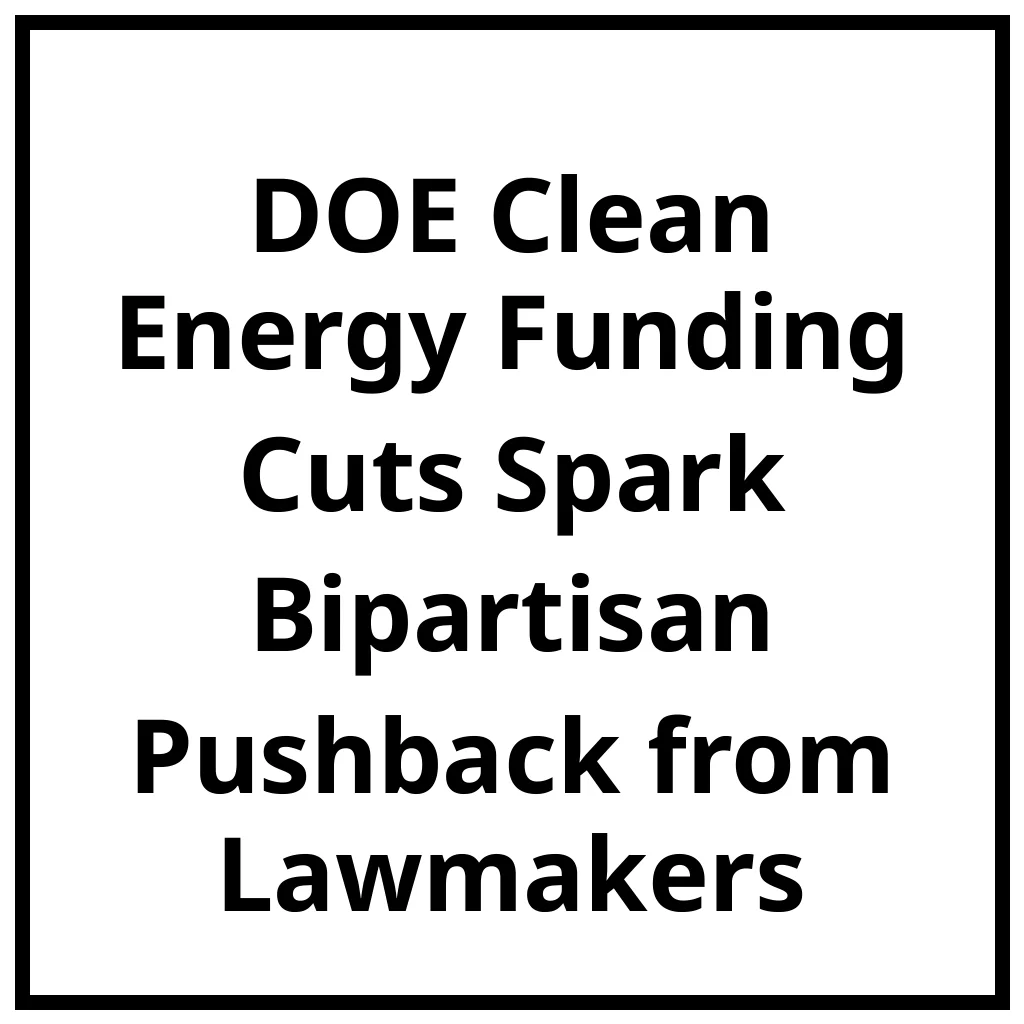The DOE clean energy funding cuts have triggered significant bipartisan pushback among lawmakers, highlighting the importance of clean energy investments.

In a shocking move that has sent ripples through the political landscape, the U.S. Department of Energy (DOE) is drafting a list of clean energy projects that could face significant funding cuts. This initiative has ignited fierce bipartisan resistance among lawmakers, who are rallying to protect the very projects that promise to alleviate climate change’s toll on our environment and bolster local economies. As this situation unfolds, the implications of these potential cuts could reshape the landscape of renewable energy in America.
Read Also – 👉👉Bucks County Tesla Vandalism Incident: A Disturbing Act of Hate and Its Community Impact👈👈
Understanding the DOE’s Clean Energy Project Hit List
Background of the DOE’s Financial Review
The DOE’s initiative to compile a hit list of clean energy projects isn’t just a random bureaucratic maneuver; it’s deeply rooted in the current political climate. Under the Biden administration, numerous legislative packages—most notably the Inflation Reduction Act and the Bipartisan Infrastructure Law—funneled billions of dollars into clean energy projects. These ambitious funding efforts were crafted to fast-track the transition toward renewable energy sources, ultimately aiming to combat global warming by reducing greenhouse gas emissions. However, the Trump administration’s renewed focus on cutting government spending has turned these projects into a target for review, placing their future at risk. With the DOE preparing to submit this controversial list to the White House, lawmakers are left scrambling to protect the critical initiatives that could be cut.
Impact on Regions and Politicization of Energy Funding
As the hit list circulates among lawmakers, the ramifications are becoming increasingly apparent, especially for those from states that could be adversely affected. The proposed cuts involve essential projects like hydrogen hubs, which are pivotal for using hydrogen as a clean fuel source, particularly in industries such as steel production and electricity generation. Notably, this situation presents a stark contrast in how states perceived as Democratic-leaning versus Republican-leaning are treated, highlighting potential biases in the funding cuts. States advocating for clean energy initiatives, like California and Washington, are putting up a formidable fight to protect their projects, while those in Texas and Ohio appear to see less scrutiny. This stark division raises pivotal questions about the fairness of the review process and its implications for regional economic development.
Bipartisan Pushback: A Unified Front on Clean Energy
Lawmakers Rallying for Local Interests
In midst of this turmoil, lawmakers from both sides of the aisle are uniting to ensure the protection of clean energy projects that directly impact their constituents. Many of them argue that the DOE’s action is an unprecedented politicization of federal funding that risks harming regions that have meaningfully invested in renewable energy infrastructure. Projects like the Pacific Northwest hydrogen hub and the ARCHES hub in California have found significant support among residents and state officials alike. Biased funding decisions, they argue, not only jeopardize environmental goals but also threaten local jobs and economic growth, keeping communities dependent on outdated fossil fuel industries. This emerging bipartisan coalition indicates that energy policy may transcend traditional party lines when the stakes involve a sustainable future.
Statements from Key Industry Leaders
As concerns escalate over the potential funding cuts, industry leaders have amplified their voices, expressing worries about the economic and environmental consequences of these actions. Frank Wolak, the CEO of the Fuel Cell and Hydrogen Energy Association, has emphasized the importance of hydrogen projects to both the economy and the fight against climate change. Moreover, Wolak stresses that any cancellations of ongoing projects would require congressional action, highlighting the crucial role lawmakers have in safeguarding these initiatives. The anxiety among key stakeholders in the clean energy sector signals a critical moment where industry and political landscapes are colliding, further complicating the narrative around DOE funding cuts.
The Consequences of DOE Clean Energy Funding Cuts
Environmental and Economic Ramifications
The potential cuts to clean energy projects are not merely a matter of budget; they possess profound environmental and economic implications that could reverberate across the entire nation. Without sufficient funding, efforts to decarbonize industries—particularly those fundamental to modern economies, such as steel production—could stall or regress significantly. This setback not only undermines progress in reducing greenhouse gas emissions but could also provoke a backlash from communities that are striving to implement more sustainable energy solutions. Moreover, the loss of funding for these projects also translates into lost opportunities for job creation and economic revitalization, especially in regions that depend on clean energy initiatives as a lifeline for growth.
Navigating Political Polarization
The current controversies surrounding the DOE’s funding cuts showcase the stark political polarization lingering in Washington. The perception that funding is allocated based on political affiliations adds a layer of complexity to what should ideally be a nonpartisan issue focusing solely on environmental benefits. As public outcry grows, the potential for political fallout from such cuts becomes pronounced. Lawmakers may face backlash from constituents who feel neglected in favor of political agendas. This rising tension may compel politicians to seek bipartisan solutions, fostering cooperation among decision-makers who may otherwise divide along party lines over energy policy.
Looking Ahead: The Future of Clean Energy Funding
Possible Paths Forward for Clean Energy Initiatives
As this delicate situation unfolds, several outcomes could emerge as lawmakers work to influence decisions around the DOE’s clean energy funding cuts. One path forward might involve congressional actions aimed at safeguarding funding through new legislative measures or amendments to existing spending bills. This would demonstrate a unified stance across party lines in favor of clean energy projects, potentially preserving vital funding channels for critical initiatives. Concurrently, there’s the possibility that the administration may face legal challenges if it proceeds with cuts seen as politically motivated. Increased collaboration between both parties rooted in shared values surrounding energy independence and sustainability presents an optimistic avenue for the future, emphasizing collective action over partisan divides.
The Importance of Bipartisanship
The unfolding situation around the DOE’s project list has illuminated the crucial nature of bipartisan cooperation in influencing energy policy. As the stakes rise concerning funding cuts for clean energy projects, lawmakers from different political backgrounds are increasingly acknowledging the long-term implications of these initiatives on both the economy and the environment. The shared goal of protecting vital investments demonstrates that when it comes to the future of energy in America, there is potential for common ground to be found, allowing lawmakers to transcend partisan politics in favor of a sustainable and prosperous tomorrow.
Conclusion: The Path Forward for Clean Energy
The controversy surrounding the DOE clean energy funding cuts serves as a potent reminder of the intricate connection between political decisions and environmental goals. As the energy landscape continues to evolve, lawmakers face mounting pressure to navigate these challenging waters while advocating for their constituents. The bipartisan pushback signifies that there’s a growing recognition of the critical role clean energy plays not only in addressing climate change but also in promoting economic sustainability. The ultimate outcome will shape the future of clean energy funding in the U.S. and likely prompt deeper discussions about how to achieve meaningful environmental progress across party lines.
FAQs
What projects are at risk of funding cuts from the DOE?
The Department of Energy’s draft of potential funding cuts has put several vital clean energy projects in jeopardy. Key initiatives under scrutiny include hydrogen production hubs, which are critical for developing hydrogen fuel for the steelmaking industry and electricity generation. Also facing potential cuts are carbon capture facilities, long-duration energy storage projects, and various solar and wind energy programs. These initiatives are not just important for their environmental benefits but also for the economic advantages they provide through job creation and technological advancement.
What are the implications of these cuts for the clean energy sector?
If the Department of Energy proceeds with these funding cuts, the ramifications could be profound. For one, the reduction in support for crucial clean energy projects would likely slow down the nation’s progress toward meeting climate goals aimed at reducing greenhouse gas emissions. Economically, these cuts could lead to job losses in sectors poised for growth, especially in regions that have invested heavily in clean energy infrastructures, such as hydrogen and solar power. The potential loss of government support could also deter private investment, slowing the transition to sustainable energy sources and consequently undermining economic revival in key states.
How can lawmakers push back against these proposed cuts?
In light of the proposed cuts to clean energy projects, lawmakers are exploring several strategies to push back effectively. A likely approach could involve rallying bipartisan support in Congress to introduce legislation aimed at protecting funding for these initiatives. By attaching provisions to upcoming spending bills, lawmakers can advocate for the preservation of clean energy investments. Furthermore, legislators may seek to engage with their respective constituencies, highlighting the economic and environmental benefits of these programs. By fostering collaboration and emphasizing the importance of clean energy, lawmakers can create a unified front against the proposed cuts.
Related Videos
Read Also –
This article reflects the ongoing political debate surrounding clean energy funding in the United States and aims to inform readers about the constituency dynamics and potential outcomes of the DOE’s proposed cuts.
Read Also –
| https://www.govinfo.gov/content/pkg/CHRG-117shrg47302/html/CHRG-117shrg47302.htm |
| https://www.politico.com/news/2025/03/26/energy-department-hydrogen-projects-blue-states-00249589 |
Hey! I hope you enjoyed reading this! If you did, could you do me a small favor and hit the like button? It would mean a lot to me and help me reach more people. Thank you so much! Got any thoughts on this post? Drop them in the comments below!
How many stars would you give for my effort?





